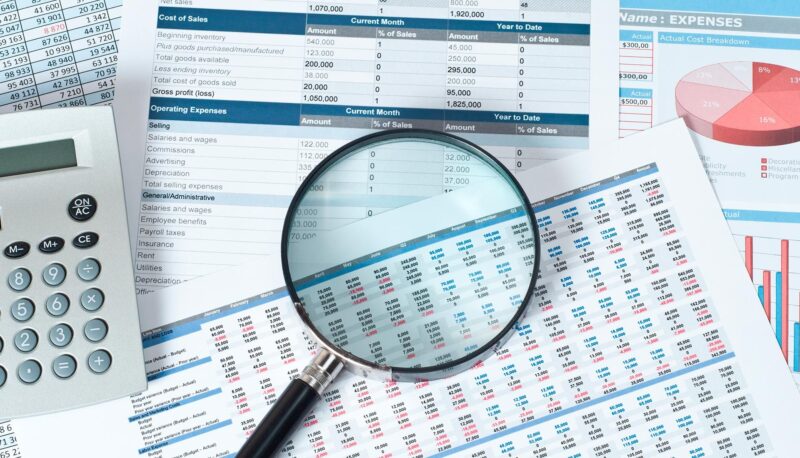Have you ever taken time to think about how businesses keep track of their finances? Or how transactions are recorded and converted into useful financial information for decision-making? It’s no easy task, yet the accounting cycle makes it seem effortless. An accounting cycle is a fundamental process used to record, classify, summarize, and report financial transactions. For every business owner, having a complete understanding of this cycle is a must in order to make sure their finances are managed accurately and efficiently.
This article delves into the twelve essential steps in the accounting cycle every business owner should be familiar with.
Page Contents
Identification And Analysis of Business Transactions
The first step in the accounting cycle is identifying and analyzing business transactions. This involves reviewing documents such as invoices, receipts, bills, and other financial documents to accurately record and evaluate a company’s finances. Financial transactions such as purchasing goods, selling services, paying employees, and acquiring assets should also be analyzed to determine their impact on the business’s assets, liabilities, and equity.
Journalizing Transactions

After identifying and analyzing all transactions, the next step is to record them in a general ledger. In journalizing, each transaction should be recorded in the appropriate journal with debits and credits for the corresponding accounts. This ensures that all accounting information is recorded accurately and consistently. To make this process more effective, businesses should accept payments online so that they can easily record transactions in their online accounting systems.
Posting To The General Ledger
Once transactions are recorded in the journal, they are then posted to the general ledger. A general ledger is a collection of accounts used to store and record financial information. It is the backbone of any bookkeeping system, as it records all transactions related to assets, liabilities, income, expenses, equity, and other revenue/cost items. When all this data is stored in the general ledger, it can be organized and used to generate financial statements and reports for business owners to evaluate.
Preparing A Trial Balance
In this step, the accountant takes all the accounts from the general ledger and prepares a trial balance. The primary purpose of a trial balance is to ensure that the total debits equal the total credits in the financial records, verifying the arithmetic accuracy of the accounting system. If the total entries agree, then it means there are no errors in the transactions recorded. This is the stage where you can identify any discrepancies in the system and take corrective actions.
Making Adjusting Entries
At the end of an accounting period, certain entries may need to be made in order to adjust for items that were not recorded during the period. These adjustments can include prepaid expenses, accrued revenues, accrued expenses, and unearned revenues. Adjusting entries ensure that the company’s financial statements comply with the accrual basis of accounting.
Preparing Financial Statements

The final step in the accounting cycle is the preparation of the financial statements. These include the income statement, the balance sheet, the statement of owner’s equity, and the cash flow statement. The statements provide a comprehensive overview of the company’s financial position and performance over the accounting period. After the financial statements are completed and approved, they are distributed to stakeholders, such as investors, creditors, and management.
Reviewing and Correcting Errors
In the accounting cycle, the step of reviewing and correcting errors is crucial to maintain accurate financial records. This stage involves carefully scrutinizing all transactions and documents to identify any discrepancies or mistakes. Errors can occur due to various reasons, such as data entry errors, mathematical miscalculations, or incorrect categorization of transactions. Accountants must meticulously examine the records, comparing them with source documents and other supporting evidence, to ensure the accuracy and integrity of the financial information.
Performing Bank Reconciliations
Bank reconciliations play a vital role in the accounting cycle, as they ensure that the company’s records accurately reflect its financial position. This step involves comparing the company’s bank statement with its internal records to reconcile any differences or discrepancies. Discrepancies may arise due to timing differences, such as outstanding checks or deposits in transit, as well as bank errors or unauthorized transactions.
Compiling and Analyzing Financial Data

Compiling and analyzing financial data is a critical step in the accounting cycle that provides valuable insights into the company’s performance and financial health. This process involves gathering all relevant financial information, such as trial balances, ledgers, and supporting documentation, to prepare financial reports and statements.
Creating Closing Entries
Creating closing entries marks the end of an accounting period and prepares the books for the next period. This step involves transferring the temporary account balances, such as revenue and expense accounts, to the appropriate permanent accounts. Closing entries reset the temporary accounts to zero and ensure that the balances accurately reflect the financial results for the period.
Conducting Internal Audits
Internal audits are an essential part of the accounting cycle, serving as a systematic review of an organization’s financial records, controls, and processes. This step involves conducting comprehensive examinations to evaluate the effectiveness of internal controls, identify potential risks, and detect any irregularities or fraudulent activities. During internal audits, trained auditors review financial statements, supporting documents, and transaction records.
Completing the Closing Process
Completing the closing process is the final step in the accounting cycle, where all necessary adjustments and procedures are performed to close the books for the accounting period. This process ensures that the financial records are accurate, the temporary accounts have been closed, and the financial statements are ready for distribution to stakeholders. Accountants review the trial balance and general ledger, making any final adjustments or corrections.
Final Thought
The accounting cycle is an essential aspect of financial management in a business entity. Proper execution of the accounting cycle is not only critical for internal management but also for external stakeholders who rely on accurate financial information to make informed decisions about the company. Armed with the above twelve steps, you have the knowledge and tools necessary to successfully navigate your way through the accounting cycle. Good luck!






